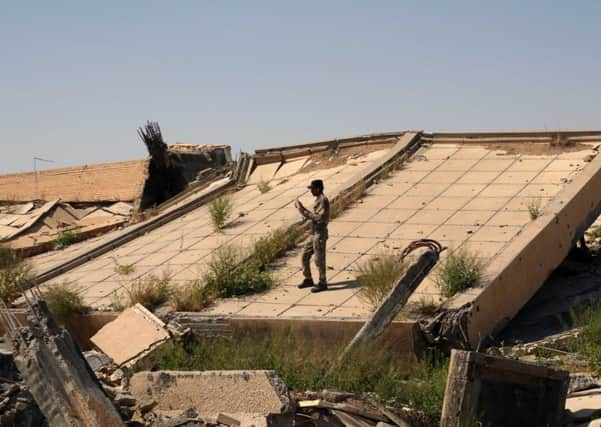Saddam Hussein tomb destroyed in IS Tikrit clashes


Video from the village of Ouja, just south of Tikrit, shows all that remains of Hussein’s once-lavish tomb are the support columns that held up the roof. Poster-sized pictures of Saddam, which once covered the mausoleum, are now nowhere to be seen amid the mountains of concrete rubble.
Instead of the posters of the executed dictator, Shiite militia flags and photos of militia leaders mark the predominantly Sunni village, including that of Major General Qassem Soleimani – the powerful Iranian general advising Iraqi Shiite militias on the battlefield.
Advertisement
Hide AdAdvertisement
Hide Ad“This is one of the areas where IS militants massed the most because Saddam’s grave is here,” said Captain Yasser Nu’ma, an official with the Shiite militias, formerly known as the Popular Mobilisation Forces. “The IS militants set an ambush for us by planting bombs around’ the tomb.”
IS has controlled Tikrit since June, when it waged its lightning offensive that saw Iraq’s second-largest city, Mosul, come under their control.
The terrorist group was helped in its conquest of northern Iraq by Saddam loyalists, including military veterans, who appealed to Sunnis who felt victimised by Baghdad’s Shiite-dominated government.
IS claimed in August that Saddam’s tomb had been completely destroyed, but local officials said that, although it had been ransacked and burnt, the building suffered only minor damage.
Saddam Hussein was captured by US forces in 2003 and was executed by hanging in December 2006 after an Iraqi special tribunal found him guilty of crimes against humanity for the mass killing of Shiites and Kurds.
His body has been kept in the mausoleum in his birthplace, Ouja, since 2007.
The complex featured a marble octagon at the centre of which a bed of fresh flowers covered the place where his body was buried. The chandelier at its centre was reminiscent of the extravagant life he led until US-led coalition forces toppled him in 2003.
Iraqi media reported last year that the dictator’s body was removed by loyalists amid fears that it would be disturbed in the fighting. Its current location is not known.
Advertisement
Hide AdAdvertisement
Hide AdConcerns are mounting that Iraq’s Shiite militias, of which an estimated 20,000 are fighting in Tikrit, will carry out revenge attacks on this and other areas that are home to predominantly Sunni residents.
Amnesty International last year said the militias wear military uniforms but operate outside any legal framework and without any official oversight, adding that they are not prosecuted for their crimes.
Earlier this month, Human Rights Watch echoed those concerns, calling on the Iraqi government to protect civilians in Tikrit and allow them to flee combat zones.
Its statement noted “numerous atrocities” against Sunni civilians by pro-government militias and security forces.
Tikrit has already been heavily damaged in months of fighting and violence.
FOLLOW US
SCOTSMAN TABLET AND MOBILE APPS